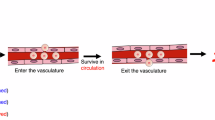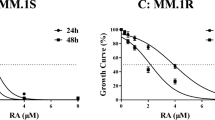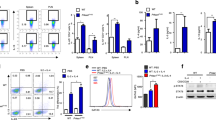Abstract
Suppression of anoikis after detachment of cancer cells from the extracellular matrix is a key step during metastasis. Here we show that, after detachment, mouse embryonic fibroblasts (MEFs) transformed by K-Ras(V12) or ETV6-NTRK3 (EN) activate a transcriptional response overrepresented by genes related to bioenergetic stress and the AMP-activated protein kinase (AMPK) energy-sensing pathway. Accordingly, AMPK is activated in both transformed and non-transformed cells after detachment, and AMPK deficiency restores anoikis to transformed MEFs. However, AMPK activation represses the mTOR complex-1 (mTORC1) pathway only in transformed cells, suggesting a key role for AMPK-mediated mTORC1 inhibition in the suppression of anoikis. Consistent with this, AMPK−/− MEFs transformed by EN or K-Ras show sustained mTORC1 activation after detachment and fail to suppress anoikis. Transformed TSC1−/− MEFs, which are incapable of suppressing mTORC1, also undergo anoikis after detachment, which is reversed by mTORC1 inhibitors. Furthermore, transformed AMPK−/− and TSC1−/− MEFs both have higher total protein synthesis rates than wild-type controls, and translation inhibition using cycloheximide partially restores their anoikis resistance, indicating a mechanism whereby mTORC1 inhibition suppresses anoikis. Finally, breast carcinoma cell lines show similar detachment-induced AMPK/mTORC1 activation and restoration of anoikis by AMPK inhibition. Our data implicate AMPK-mediated mTORC1 inhibition and suppression of protein synthesis as a means for bioenergetic conservation during detachment, thus promoting anoikis resistance.
Similar content being viewed by others
Log in or create a free account to read this content
Gain free access to this article, as well as selected content from this journal and more on nature.com
or
Abbreviations
- AMPK:
-
AMP-activated protein kinase
- CHX:
-
cycloheximide
- DN:
-
dominant negative
- EN:
-
ETV6-NTRK3
- FACS:
-
fluorescence-activated cell sorting
- GEP:
-
gene expression profile
- GO:
-
gene ontology
- GSEA:
-
Gene Set Enrichment Analysis
- LDH:
-
lactate dehydrogenase
- MEF:
-
mouse embryonic fibroblast
- mTORC1:
-
mTOR complex-1
- TSC:
-
tuberous sclerosis complex
- wt :
-
wild type.
References
Frisch SM, Francis H . Disruption of epithelial cell–matrix interactions induces apoptosis. J Cell Biol 1994; 124: 619–626.
Simpson CD, Anyiwe K, Schimmer AD . Anoikis resistance and tumor metastasis. Cancer Lett 2008; 272: 177–185.
Khwaja A, Rodriguez-Viciana P, Wennstrom S, Warne PH, Downward J . Matrix adhesion and Ras transformation both activate a phosphoinositide 3-OH kinase and protein kinase B/Akt cellular survival pathway. EMBO J 1997; 16: 2783–2793.
Douma S, Van Laar T, Zevenhoven J, Meuwissen R, Van Garderen E, Peeper DS . Suppression of anoikis and induction of metastasis by the neurotrophic receptor TrkB. Nature 2004; 430: 1034–1039.
Reginato MJ, Mills KR, Paulus JK, Lynch DK, Sgroi DC, Debnath J et al. Integrins and EGFR coordinately regulate the pro-apoptotic protein Bim to prevent anoikis. Nat Cell Biol 2003; 5: 733–740.
Valentinis B, Reiss K, Baserga R . Insulin-like growth factor-I-mediated survival from anoikis: role of cell aggregation and focal adhesion kinase. J Cell Physiol 1998; 176: 648–657.
Derksen PW, Liu X, Saridin F, van der Gulden H, Zevenhoven J, Evers B et al. Somatic inactivation of E-cadherin and p53 in mice leads to metastatic lobular mammary carcinoma through induction of anoikis resistance and angiogenesis. Cancer Cell 2006; 10: 437–449.
Martin MJ, Melnyk N, Pollard M, Bowden M, Leong H, Podor TJ et al. The insulin-like growth factor I receptor is required for Akt activation and suppression of anoikis in cells transformed by the ETV6-NTRK3 chimeric tyrosine kinase. Mol Cell Biol 2006; 26: 1754–1769.
Collins NL, Reginato MJ, Paulus JK, Sgroi DC, Labaer J, Brugge JS . G1/S cell cycle arrest provides anoikis resistance through Erk-mediated Bim suppression. Mol Cell Biol 2005; 25: 5282–5291.
Fung C, Lock R, Gao S, Salas E, Debnath J . Induction of autophagy during extracellular matrix detachment promotes cell survival. Mol Biol Cell 2008; 19: 797–806.
Schafer ZT, Grassian AR, Song L, Jiang Z, Gerhart-Hines Z, Irie HY et al. Antioxidant and oncogene rescue of metabolic defects caused by loss of matrix attachment. Nature 2009; 461: 109–113.
Sequeira SJ, Ranganathan AC, Adam AP, Iglesias BV, Farias EF, Aguirre-Ghiso JA . Inhibition of proliferation by PERK regulates mammary acinar morphogenesis and tumor formation. PLoS One 2007; 2: e615.
Rohwer N, Welzel M, Daskalow K, Pfander D, Wiedenmann B, Detjen K et al. Hypoxia-inducible factor 1alpha mediates anoikis resistance via suppression of alpha5 integrin. Cancer Res 2008; 68: 10113–10120.
Bungard D, Fuerth BJ, Zeng PY, Faubert B, Maas NL, Viollet B et al. Signaling kinase AMPK activates stress-promoted transcription via histone H2B phosphorylation. Science 2010; 329: 1201–1205.
Solimini NL, Luo J, Elledge SJ . Non-oncogene addiction and the stress phenotype of cancer cells. Cell 2007; 130: 986–988.
McGee SL, Hargreaves M . AMPK and transcriptional regulation. Front Biosci 2008; 13: 3022–3033.
Narkar VA, Downes M, Yu RT, Embler E, Wang YX, Banayo E et al. AMPK and PPARdelta agonists are exercise mimetics. Cell 2008; 134: 405–415.
Zhou J, Huang W, Tao R, Ibaragi S, Lan F, Ido Y et al. Inactivation of AMPK alters gene expression and promotes growth of prostate cancer cells. Oncogene 2009; 28: 1993–2002.
Greer EL, Oskoui PR, Banko MR, Maniar JM, Gygi MP, Gygi SP et al. The energy sensor AMP-activated protein kinase directly regulates the mammalian FOXO3 transcription factor. J Biol Chem 2007; 282: 30107–30119.
Kwiatkowski DJ, Zhang H, Bandura JL, Heiberger KM, Glogauer M, el-Hashemite N et al. A mouse model of TSC1 reveals sex-dependent lethality from liver hemangiomas, and upregulation of p70S6 kinase activity in Tsc1 null cells. Hum Mol Genet 2002; 11: 525–534.
Petroulakis E, Parsyan A, Dowling RJ, LeBacquer O, Martineau Y, Bidinosti M et al. p53-dependent translational control of senescence and transformation via 4E-BPs. Cancer Cell 2009; 16: 439–446.
Sarbassov DD, Ali SM, Sabatini DM . Growing roles for the mTOR pathway. Curr Opin Cell Biol 2005; 17: 596–603.
Buttgereit F, Brand MD . A hierarchy of ATP-consuming processes in mammalian cells. Biochem J 1995; 312 (Pt 1): 163–167.
Schneider-Poetsch T, Ju J, Eyler DE, Dang Y, Bhat S, Merrick WC et al. Inhibition of eukaryotic translation elongation by cycloheximide and lactimidomycin. Nat Chem Biol 2010; 6: 209–217.
Lee CH, Inoki K, Karbowniczek M, Petroulakis E, Sonenberg N, Henske EP et al. Constitutive mTOR activation in TSC mutants sensitizes cells to energy starvation and genomic damage via p53. EMBO J 2007; 26: 4812–4823.
Gilmore AP . Anoikis. Cell Death Differ 2005; 12 (Suppl 2): 1473–1477.
Kang HG, Jenabi JM, Zhang J, Keshelava N, Shimada H, May WA et al. E-cadherin cell–cell adhesion in Ewing tumor cells mediates suppression of anoikis through activation of the ErbB4 tyrosine kinase. Cancer Res 2007; 67: 3094–3105.
Phadke PA, Vaidya KS, Nash KT, Hurst DR, Welch DR . BRMS1 suppresses breast cancer experimental metastasis to multiple organs by inhibiting several steps of the metastatic process. Am J Pathol 2008; 172: 809–817.
El-Naggar S, Liu Y, Dean DC . Mutation of the Rb1 pathway leads to overexpression of mTor, constitutive phosphorylation of Akt on serine 473, resistance to anoikis, and a block in c-Raf activation. Mol Cell Biol 2009; 29: 5710–5717.
Vitale M, Di Matola T, Bifulco M, Casamassima A, Fenzi G, Rossi G . Apoptosis induced by denied adhesion to extracellular matrix (anoikis) in thyroid epithelial cells is p53 dependent but fails to correlate with modulation of p53 expression. FEBS Lett 1999; 462: 57–60.
Lock R, Roy S, Kenific CM, Su JS, Salas E, Ronen SM et al. Autophagy facilitates glycolysis during Ras mediated oncogenic transformation. Mol Biol Cell 2011; 22: 165–178.
Guo JY, Chen HY, Mathew R, Fan J, Strohecker AM, Karsli-Uzunbas G et al. Activated Ras requires autophagy to maintain oxidative metabolism and tumorigenesis. Genes Dev 2011; 25: 460–470.
Kim MJ, Woo SJ, Yoon CH, Lee JS, An S, Choi YH et al. Involvement of autophagy in oncogenic K-Ras-induced malignant cell transformation. J Biol Chem 2011; 286: 12924–12932.
Laderoute KR, Amin K, Calaoagan JM, Knapp M, Le T, Orduna J et al. 5′-AMP-activated protein kinase (AMPK) is induced by low-oxygen and glucose deprivation conditions found in solid-tumor microenvironments. Mol Cell Biol 2006; 26: 5336–5347.
Jones RG, Plas DR, Kubek S, Buzzai M, Mu J, Xu Y et al. AMP-activated protein kinase induces a p53-dependent metabolic checkpoint. Mol Cell 2005; 18: 283–293.
Choo AY, Kim SG, Vander Heiden MG, Mahoney SJ, Vu H, Yoon SO et al. Glucose addiction of TSC null cells is caused by failed mTORC1-dependent balancing of metabolic demand with supply. Mol Cell 2010; 38: 487–499.
Liu H, Radisky DC, Nelson CM, Zhang H, Fata JE, Roth RA et al. Mechanism of Akt1 inhibition of breast cancer cell invasion reveals a protumorigenic role for TSC2. Proc Natl Acad Sci USA 2006; 103: 4134–4139.
Dubois L, Magagnin MG, Cleven AH, Weppler SA, Grenacher B, Landuyt W et al. Inhibition of 4E-BP1 sensitizes U87 glioblastoma xenograft tumors to irradiation by decreasing hypoxia tolerance. Int J Radiat Oncol Biol Phys 2009; 73: 1219–1227.
Braunstein S, Karpisheva K, Pola C, Goldberg J, Hochman T, Yee H et al. A hypoxia-controlled cap-dependent to cap-independent translation switch in breast cancer. Mol Cell 2007; 28: 501–512.
Subramanian A, Tamayo P, Mootha VK, Mukherjee S, Ebert BL, Gillette MA et al. Gene set enrichment analysis: a knowledge-based approach for interpreting genome-wide expression profiles. Proc Natl Acad Sci USA 2005; 102: 15545–15550.
Acknowledgements
We thank B Rotblat and C Tognon helpful discussions, and T Tang and A Barokas for technical assistance. This study was funded by the US Department of Defense Grant W81XWH-07-1-0580 (to PHBS and TJT). This work was also supported by funds from the British Columbia Cancer Foundation through generous donations from Team Finn and other generous riders in the Ride to Conquer Cancer. TLN is supported by training fellowships from the Clinician Investigator Program of the Royal College of Physicians of Canada, the Canadian Institutes of Health Research (CIHR), and the Michael Smith Foundation for Health Research. We thank D Kwiatkowski, N Sonenberg, N Mizushima, and R Baserga for MEF cell lines, and W Hahn and N Hay for plasmid constructs.
Author information
Authors and Affiliations
Corresponding author
Ethics declarations
Competing interests
The authors declare no conflict of interest.
Additional information
Edited by H Ichijo
Supplementary Information accompanies the paper on Cell Death and Differentiation website
Supplementary information
Rights and permissions
About this article
Cite this article
Ng, T., Leprivier, G., Robertson, M. et al. The AMPK stress response pathway mediates anoikis resistance through inhibition of mTOR and suppression of protein synthesis. Cell Death Differ 19, 501–510 (2012). https://doi.org/10.1038/cdd.2011.119
Received:
Revised:
Accepted:
Published:
Issue date:
DOI: https://doi.org/10.1038/cdd.2011.119
Keywords
This article is cited by
-
AMPKα-like proteins as LKB1 downstream targets in cell physiology and cancer
Journal of Molecular Medicine (2021)
-
Nutrient scavenging in cancer
Nature Reviews Cancer (2018)
-
A Functional Signature Ontology (FUSION) screen detects an AMPK inhibitor with selective toxicity toward human colon tumor cells
Scientific Reports (2018)
-
Nuclear respiratory factor 1 promotes spheroid survival and mesenchymal transition in mammary epithelial cells
Oncogene (2018)
-
Glucose starvation induces LKB1-AMPK-mediated MMP-9 expression in cancer cells
Scientific Reports (2018)



